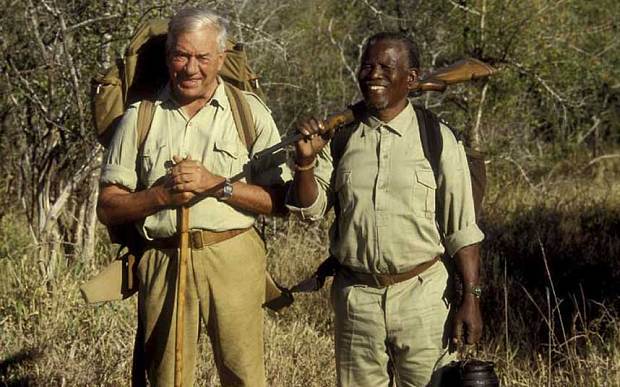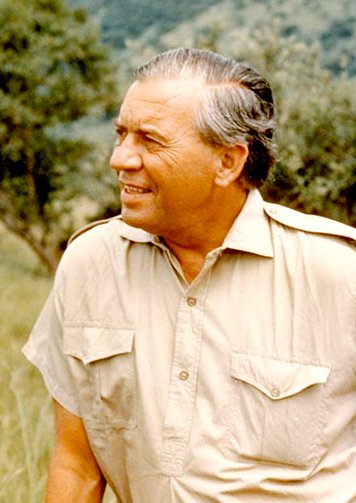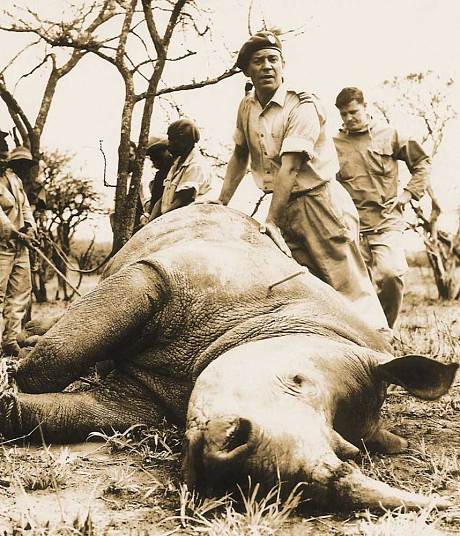Ian Player
Rhino saviour
Ian Player
Wildlife conservationist | Naturalist | Author
Environmentalist Ian Player needs little introduction in South Africa, and is famous in certain world circles. He is probably best known as the man who saved the white rhino in the 1960s, and now the rhino (both white and black) is again under threat. Player’s fight to save the rhino is topical, and conservationists can learn from his tenacity and some of his strategies.
Player's life was certainly full and an interesting one, leading from the Witwatersrand mines, where he worked as a young man, to Zululand’s glorious hills. Saving the white rhino is only one of several solid achievements. It gave him fame, and enabled him to use that fame to achieve other pinnacles. These include his Wilderness Leadership School, which takes small groups into wilderness areas in South Africa for experiential learning that focuses on the self and the psyche, and saving the St Lucia lakes on the KwaZulu-Natal north coast from mining. His work resulted in protected status for this area that has, since 1990, been a World Heritage Site. He also helped secure protected status for the Umfolozi area of KwaZulu-Natal.
Ian Cedric Audley Player DMS (15 March 1927 – 30 November 2014) was born in Johannesburg and educated at St. John’s College. He served in the 6th Armoured Division attached to the American 5th Army in Italy 1944–46.
His conservation career started with the Natal Parks Board in 1952 and whilst Warden of the Umfolozi Game Reserve, he spearheaded two key initiatives: - Operation Rhino - that saved the few remaining southern race of white rhino. - Protected status for the Umfolozi and St. Lucia Wilderness Areas (now known as the iSimangaliso Wetland Park World Heritage Site)- The first wilderness areas to be zoned in South Africa and on the African continent. Dr. Player was the Founder of the Wilderness Leadership School, which still runs the original wilderness trails to this day. This led to the formation of the Wild Foundation, the Wilderness Foundation SA, Wilderness Foundation UK, Magqubu Ntombela Foundation not to mention the World Wilderness Congresses, first convened in 1977. Amongst many orders and awards he counts Knight of the Order of the Golden Ark and the Decoration for Meritorious Service (the highest Republic of South African civilian award). He was the recipient of two honorary doctorates: Doctor of Philosophy, Honoris Causa from the University of Natal and Doctor of Laws (LLD) (h.c.) from Rhodes University. Player died on 30 November 2014 of a stroke. He was the brother of professional golfer Gary Player.Courtesey: Wikipedia.org/
WILDERNESS LEADERSHIP SCHOOL
The Wilderness Leadership School continues as one of the leading organizations in Africa providing a true wilderness experience. Now well over 55 years strong, it was originally established by Ian Player (WILD’s founder) and his Zulu brother and mentor, Magqubu Ntombela.
Ian and Magqubu defied the South African laws of apartheid at that time by taking small groups of people, often multiracial, into the wilderness of the iMfolozi Game Reserve (where Ian Player and his team saved the white rhino from extinction, a pioneering conservation story related in Operation Rhino) In a “first ever” program, for 5 days the “trailists” would (and still do) hike lightly; carry their own packs; watch (and occasionally quickly avoid!) wildlife such the rhino, elephant and lions; understand cultural lore of the Zulu people; and sleep around the fire at night, under the African stars, while listening to the roars, barks, and bellows of the African night. In the process they created multi-racial environmental experience and awareness in South Africa, created a new tourism industry, and quietly declared to the world that there is both an inner and outer connection between humankind and wild nature. We are often asked about the WLS — our sister organization and a member of our Wilderness Network — “Is it like Outward Bound?” Our answer is the same, always…”It is an inward looking Outward Bound,” encouraging people to understand themselves , consider their origins, and look to their future as they hike, sit, and dream in the landscape in which humankind evolved. Some of the many stories of experience and personal transformation are in the book South African Passage, with a foreword by the late, renowned explorer and writer, Sir Laurens van der Post (a key person in founding WILD and guiding our work for many years) The WLS operates trails in numerous locations in KwaZulu Natal, South Africa, and In Botswana.PUBLICATIONS
Men, Rivers and Canoes – 1964 - Reissued 2007 - ISBN 978-0-9802501-2-1
White Rhino Saga – 1972 - ISBN 978-0-00-211938-2 Big Game – 1972 - ASIN: B0007BO5E4 Man and the Wilderness – 1986 - ASIN: B0007BQ0FG Zululand Wilderness: Shadow and Soul – 1997 - ISBN 978-0-86486-340-9 Ian Player Perspective, stories by and about Dr. Ian PlayerSouth African Passage: Diaries of the Wilderness Leadership School by Ian C. Player
Go back to: Wildlife guardians & dedicated conservationists
Into the River of Life — A Biography of Ian Player
by Graham Linscott
From the opening adventure — Player and two friends made the first river journey that became the Dusi Canoe Marathon — this is the story of a complex character who took life by the horns. It’s an interesting tale, comprising a fair bit of derring-do matched with some dogged bureaucratic manipulation. Both have one goal in mind: conservation of the world’s wild places.
Player has held "wilderness" important since he was a very young man. His concept of wilderness as a place important to humans’ sanity and even their physical wellbeing, was already in place when he had it confirmed, ready to be consolidated by his reading of Carl Jung’s theories. Graham Linscott shows how it was this concept of wilderness and Player’s determination to conserve wild places that set him against high-ups in the Natal Parks Board. He joined the board in 1952, and remained there for about three decades, but bumped heads repeatedly with those who thought parks should cater more for recreation. From wrestling rhinos and arguing with irate fishermen who demanded fishing rights that would have jeopardised conservation goals, to delivering speeches at world conservation congresses, Player has fought tirelessly for the good of the wild. This includes his own Wilderness Leadership Congresses, the first of which was organised to be in South Africa at the height of apartheid. His battles have cost him his sight in one eye (from squirts of rhino-immobilising drugs), and most of his hearing (from the noise of shots fired while culling). They have also made him enemies, some of which Linscott appears to believe are poised to speak ill of Player once he leaves for the great wilderness in the sky. Whether or not you believe this, I hazard a guess even Player’s detractors will accede he has always had as his goal a good greater than personal gain.Go back to: Wildlife guardians & dedicated conservationists
OBITUARY FROM THE WASHINGTON POST
Ian Player, a South African conservationist credited with bringing the white rhinoceros back from the threat of extinction and who was an early promoter of environmental awareness, including the idea of eco-tourism, died Nov. 30 at his home in the KwaZulu-Natal province of South Africa. He was 87.
His death was announced by his brother, golfer Gary Player. The cause was a stroke, according to South African news accounts. Mr. Player was a park ranger in his native South Africa early in his career when he developed a deep attachment to the natural world and to the white rhinoceros in particular. “I will never forget my first view of a white rhino,” he wrote in a 2011 essay for the South African publication Business Day. “I was in the Umfolozi Game Reserve in 1952. . . . It was a misty morning and I was looking into a patch of bush when two white rhino came looming out of the mist, with steam rising from their flanks and their backs. . . . Something within me was deeply touched by this primeval scene, and I had an intuitive flash that somehow my life would be bound up with these great prehistoric animals.”The white rhinoceros — which is actually a drab gray in color — is the biggest of five species of rhino. After the elephant, it is the world’s largest land mammal, weighing as much as four tons. It has long been prized by hunters and, in recent years, by poachers who believe its horn possesses magical properties.
Ian Player (left) and Magqubu Ntombela. (Photo by Trevor Barrett) When Mr. Player conducted an airborne survey of his South African game reserve in 1953, he counted 437 white rhinos. Thousands lived in central Africa at the time, but that population has been wiped out. Mr. Player set about finding ways to increase the rhino’s chances of survival. He led efforts to move groups of the them to other locations, including South Africa’s sprawling Kruger National Park, in order to increase its long-term chances of survival. He launched Operation Rhino in the 1960s, traveling around the world to heighten public awareness of the plight of the rhino and African wildlife in general. He was the technical adviser on the 1964 Hollywood movie “Rhino!” He published a book, “The White Rhino Saga ,” in 1972 and worked with documentary filmmakers to draw attention to the animals.“Conservation is not a plaything, or a luxury, or something new,” Mr. Player told Sports Illustrated in 1972. “It is survival. Before we can develop an ecological conscience about the world in which we live . . . we must be able to see a strip of land that has not been maltreated by man. We must experience wilderness.”
Mr. Player organized efforts to establish breeding colonies in zoos and parks outside Africa, including the San Diego Zoo. Once, while trying to immobilize a rhino, Mr. Player was accidentally squirted with a tranquilizer drug, causing him to lose much of the sight in his right eye. For years, Mr. Player faced widespread hostility in his homeland from farmers, hunters, commercial interests and others who thought he was standing in the way of progress. But he foresaw the economic value of preserving nature and became an early advocate of what is now called eco-tourism. Instead of hunting parties, Mr. Player helped organize outings in which visitors could witness wildlife roaming free in their natural habitat.The World Wildlife Fund once called Mr. Player the “savior” of the white rhino, whose numbers have grown in recent years to an estimated 20,000.
Ian Cedric Audley Player was born March 15, 1927, in Johannesburg. His father sold gold-mining equipment.
Mr. Player was interested in physical fitness in his youth. Gary Player, who won the Masters and British Open tournaments three times each, told Sports Illustrated that his older brother fashioned his first golf club from a tree branch and taught him the rudiments of the sport. Mr. Player left school at 16 to serve in the South African army during World War II and saw combat alongside U.S. forces in Italy. Returning to his homeland, he was a fisherman and gold miner before organizing a 75-mile canoe race in 1951. He won the six-day race three times. It was during the first of those races, when he went through rapids and other obstacles and was bitten by poisonous snakes, that Mr. Player determined to spend his life in nature.He also was a follower of the practice of dream interpretation and was a founder of a South African society devoted to the study of the ideas of psychotherapist Carl Jung.
Survivors include his wife of 57 years, Anne Farrer Player; three children; his brother; and a sister. Mr. Player was the author of three books and, from 1976 to 1993, wrote a column on the outdoors for a South African newspaper. He lectured around the world and established a school to train young people about nature and wildlife. In the 1970s, he was a founder of the World Wilderness Congress, an international forum that brings together scientists, financiers and environmental activists. He also stood out for his outspoken support of black culture in South Africa, and his closest friend was a Zulu park ranger named Magqubu Ntombela, who taught Mr. Player how to track animals in the bush. “The wilderness has no perception of race,” Mr. Player told The Washington Post in 1984. “That is where the inner change can take place.”FOR MORE GREAT STORIES AND REMEMBERENCES:
Conservation Pioneer and Legend, Dr Ian Player from The Wilderness Foundation Africa
Memorial tribute to Ian Player by Ian McCallum (PDF)
Natal Society Foundation - Obituary for Ian Player (PDF)



